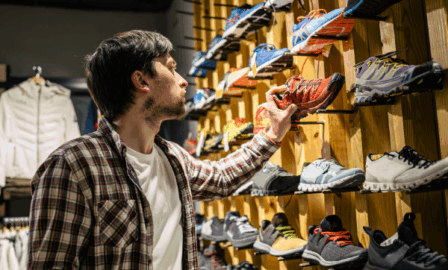Apparel Industry Outlook: Assessing Our 2023 Trends Report
In January, our retail experts made a number of predictions about the apparel industry outlook for 2023. As we move into the second half of the year, let’s see how well our predictions held up for the five trends discussed in our 2023 Apparel Industry Trends report.
Trend Review
Trend #1: Conscientious customers are forcing brands to rethink sustainable apparel.
When predicting conscientious customers forcing brands to rethink sustainable apparel, our assumptions were on par with current trends in the market. We want to expand our initial predictions in the coming months regarding sustainability. The apparel industry is pointing to a continued increase in sustainability efforts, not just in materials being used but in sustainable business practices. This hot-button topic poses a challenge to major retailers as they make concerted efforts to reduce lasting negative impacts on the planet. For example, companies like Patagonia are embracing this concept by using sustainable materials and providing their customers with services to repair their clothing to encourage customers to wear it for a lifetime.
When considering manufacturing, transportation, packaging products, and reverse logistics practices, many brands have a ways to go to fully mitigate harmful impacts on the environment. Sustainability will continue to be a topic of discussion in apparel as brands look to find creative solutions to incorporate sustainable practices in their current strategy.
Trend #2: Customers continue to desire customization and personalization
There is certainly still a niche in the apparel industry for customized clothing. At the top of the year, we predicted that shoppers would continue seeking personalized attire, but that has taken a more technical turn these past few months. The continued evolution of technology is forcing the apparel industry to embrace AI and be at the forefront of cutting-edge technology.
More than 9 in 10 businesses are already using AI-driven personalization to increase growth in their business. With the magnitude of data being acquired from different channels, companies must utilize AI to capture and synthesize meaningful data to curate these personalized shopping experiences customers expect and want. As retail technology evolves, an increasing number of retailers will find competitive advantages by incorporating AI in most aspects of operations, ranging from planning carefully curated assortments to predicting the in-store shopping behavior of guests.
Trend #3: Demand to increase as supply recovers
As society recovers from the residual effects of Covid-19 and its tumultuous impacts on supply chains, we imagined demand would recover as companies stabilized their supply chain challenges. Although our initial prediction was partially correct, supply did make a meaningful recovery. Still, customers aired on the side of caution as they waited to see how the economy would recover from the unusual effects of the pandemic. Consumer behavior reports in December showed smaller budgets continue to lead 55.2% of customers to buy fewer non-food items, which is down from 59.8% in the previous month.
What surprised the retail industry was the economic health of our society post-Covid. Inflation threatened the strong customer demand we had hoped to see at the top of the year. As of May 2023, inflation has been trending down, giving retailers some semblance of predictable customer spending in the coming months. We can reference Target’s mid-quarter warning last June when they announced a significant hit on mid-quarter profits as they tried to predict the right-size inventory. Like most economists, they blamed inflation and customers’ desire to spend on essentials such as food and gas. We hope to continue to see inventory levels recover for retailers and shoppers accelerate spending on non-essential items. In fact, recent retail spending analysis points to an optimistic outlook for the remainder of 2023, as customer spending shifts back to non-essential categories.
Trend #4: Interacting in the metaverse is no longer optional but required to stay relevant
Much like AI changing the landscape of personalized shopping experiences, we see a continued trend in interacting in the metaverse for the apparel industry. This past March, Metaverse held its 2nd annual fashion week, with more than 60 luxury fashion and digitally native brands debuting wearable collections and online spaces. When our experts initially made their 2023 apparel industry outlook report, only a few companies seized technology and gamification of the customer experience. Now we’re continuing to see more and more companies acknowledging the importance of embracing technology and the change it brings with it.
Walmart and Amazon, for example, have embraced technology and expanded their virtual reality capabilities to allow customers to try on clothing using digital representations of themselves virtually. It’s becoming more evident that investment in digital experiences is part of the retail landscape. Some experts prematurely predicted the “retail apocalypse” at the pandemic’s peak. Hindsight is 20/20; now experts understand the shopper’s desire to want an in-store experience while cultivating a seamless hybrid experience among all channels of their shopping journey.
Trend #5: Apparel will remain a vehicle of expression for DE+I
At the start of the year, we highlighted how current events and social issues impacted the fabric of our lives. We focused on the increase of minority-owned tags on labels merging causes with apparel. During the pandemic, there was a rise in social media and news outlets spotlighting racial injustices that influenced how corporations interacted with the public. A continued increase in consumer social awareness motivates companies to enhance those DE+I initiatives. Gone are the days of under-informed shoppers – the average customer now has endless data at their fingertips to inform the path to purchase. They now associate their purchased items with their personal brand and increasingly voice their support through their wallets for brands that most closely align with their sense of self. Customers more readily support brands that are inclusive, and unsurprisingly tech is here to help. In recent months, Levi’s has begun testing AI-generated clothing models. While still experimental, curating a product assortment modeled by a diverse group of individuals allows more shoppers to see themselves in the clothes they’re browsing.
Apparel Industry Outlook: Looking Ahead to 2024
All in all, these trends are interconnected and here to stay. Not a single trend is insulated in its impact on other business areas because they all affect one another. Retailers must continue to be customer obsessed at the heart of every company-wide initiative. As technical advances further accelerate access to contextualized information, customers will have an ever-increasing wealth of knowledge at their fingertips. This access to information has given customers a seat at the table, and retailers need to be mindful of keeping their initiatives closely aligned with the needs of their conscious customers.
Technology has also fostered a stronger focus on a personalized shopping experience. We expect to see a continued increase in companies investing in technology that streamlines processes and blurs the lines of virtual and in-person shopping experiences. We still predict demand to increase as the supply chain recovers from the pandemic. With technology advancing and shoppers feeling empowered and connected to brands they invest in, we will continue to see the apparel industry morphing to keep up with its customer base. Apparel is seen as an expression of oneself; therefore, as society evolves, retailers will need to keep up with those changes to meet demand and exceed expectations.
Brands must actively keep a pulse of what their target audiences desire. To accomplish this, they must reassess their strategy, technology stack, and internal initiatives to align with the trends driven by consumers and the state of the economy. Reach out to our apparel and retail experts to ensure your strategies are making the most of today’s latest innovations.



